Jungle curry (kaeng pa | แกงป่า) is a watery, hot and spicy Northern Thai curry made without coconut milk. Because, surprise, surprise, coconut trees don't grow in mountain forests.
Originally made with wild boar, jungle curry can be made with chicken, pork, lamb, seafood or even vegan.
The base is made with homemade Thai red curry paste, but you can easily use a good store bought brand too.

Jump to:
Ingredients
For the lamb stock

- Bones - Any lamb bones. If you're making a chicken version, use chicken carcasses or wings. If you're making it vegan, then simply use more vegetables.
- Aromatics - Onion, carrot, garlic, lemongrass and galangal trim if you have some left over from making Thai red curry paste.
For the curry
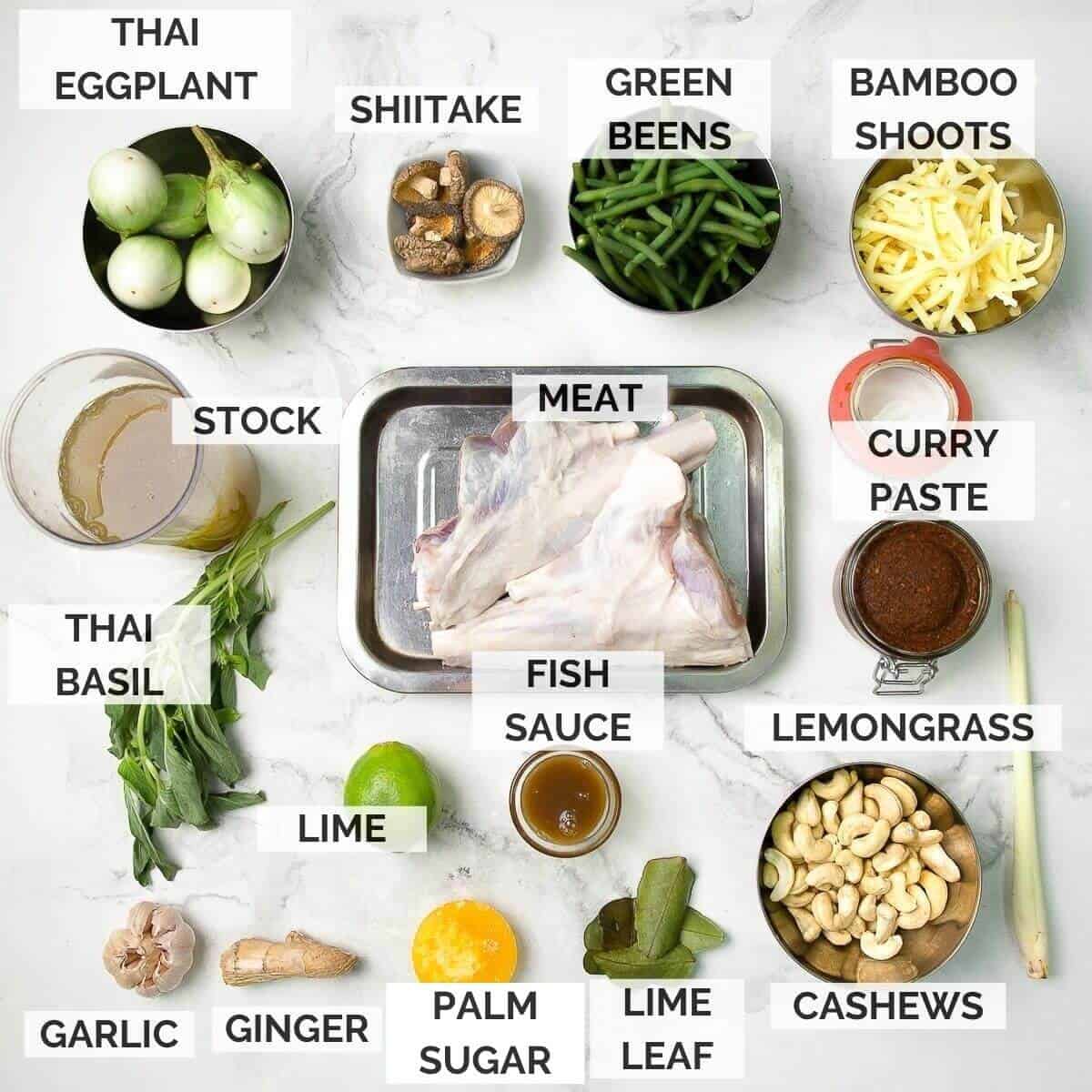
- Meat - We use lamb shank, but you can use pork neck, pork ribs or belly, chicken things, seafood or just keep it veggie.
- Curry paste - Thai red curry paste is jungle curry paste. There is no separate recipe uniquely jungle curry. It differs from green curry paste or massaman curry paste considerably. Best to either make your own, or Mae Ploy does a good one.
- Vegetables - Usually Thai aubergines, green beans or snake beans, bamboo shoots, carrots and some kind of mushroom like shiitake are used. There are no hard and fast rules. Curries are the same as stews and soups. Their origins are not from the rich or noble but rather from farmers and working class that use what they have at the time.
- Aromatics - Lemongrass, ginger, kaffir lime leaf and garlic. Use them either fresh or frozen at worst. Dried does not do a good job.
- Cashew nuts (optional) - Cashew nuts are highly recommended, but they are optional.
- Fish sauce - Fermented fish sauce or shrimp paste forms a huge part of Thai and South East Asian cuisine. It's a way of seasoning and bringing umami and flavour to food. If you're making a vegan version, use soy sauce.
- Thai basil - Different from regular basil and if you can't find it use normal basil or cilantro.
- Liquid - Jungle curry is a watery curry, but it does not mean diluting flavour with water. Use a stock of any kind at least instead of plain water.
- Palm sugar - Palm sugar or coconut sugar. Often comes in hard pucks in the west. Use the soft palm sugar if you can get it. It has a beautiful molasses-butterscotch flavour not found in regular white sugar.
Instructions
Stock
- Place the bones into a large pot and bring to a boil in salted water. This is to clean them and get rid of any impurities.
- Drain the bones once boiled and place the bones back into the pot along with the aromatics.
- Add just enough water to cover and simmer slowly for 3 hours.
- Strain through a sieve and discard the bones and aromatics.
Curry
If you're making this with larger whole pieces of meat like the lamb shank we're using or chicken on the bone, I suggest you brine the meat first for best results.
It keeps the meat juicy and seasons it throughout.
If using smaller cuts, there's no need for brining.
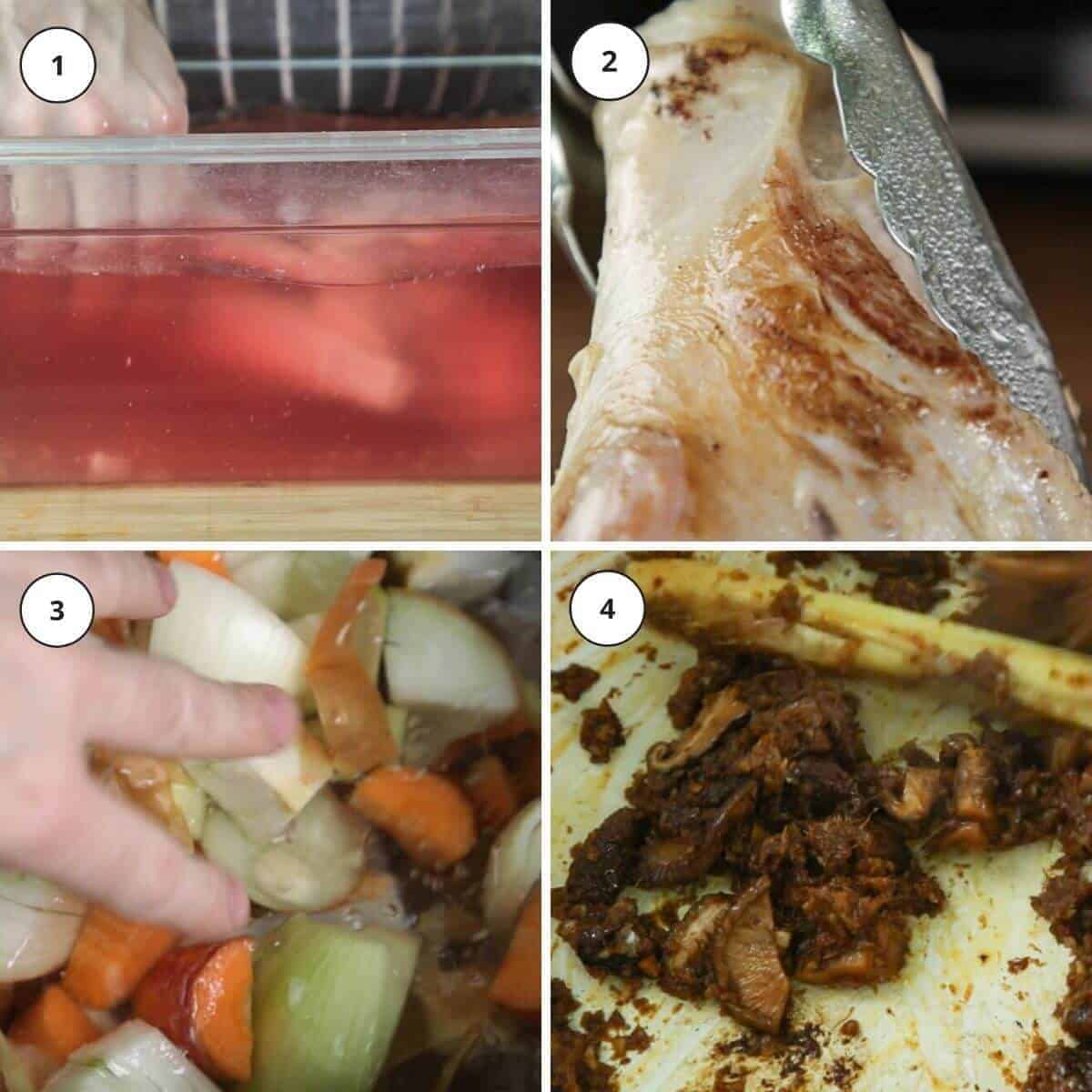
- Soak the meat in a 2% salted brine solution for 12 hours.
- Roast the cashews at 180° F or 356° F for 7 minutes and set aside to cool before chopping roughly.
- Rehydrate the shiitake mushrooms if using dried before slicing finely.
- Remove the meat from the brine and dry it on a kitchen towel before frying in a casserole until nicely browned before removing and setting aside.
- Purée or chop the ginger and garlic very finely, then fry on medium heat in the same casserole without caramelizing.
- Add the shiitake, lemongrass, and curry paste, then fry until fragrant.

- Add the meat back into the casserole, followed by the lamb stock, cashews, fish sauce, palm sugar and lime leaf. If you cook something like lamb shank, then cook it at 110° C or 230° F overnight. Alternatively, simmer gently until tender. Topping up with stock or water if it gets too dry. Keep the lid on the casserole while cooking.
- Once the meat is soft, add sliced carrots and Thai aubergine and cook for a few minutes until tender, before adding the green beans and bamboo shoots, followed by lime zest, juice and any final balance adjustment if needed.
- Serve straight away with Thai basil and rice, or chill down for later.
Video
Tips for success
Ingredients
- The most important ingredient in a Thai curry is the curry paste, which carry most of the flavour. Make your own Jungle curry paste or buy a good brand, but don't skip it.
- Do not use dry lime leaf or lemongrass. It won't make a tasty curry.
Cooking
- Meat cooked on the bone will be tastier, but it takes longer to cook. Alternatively, if you want a quick curry in 30 minutes, use tender meat like chicken thigh, pork neck, or shrimp cut into bite sized chunks.
- Make sure to add vegetables in order of their required cooking time to get soft. Hard veg like carrots, potatoes and pumpkin takes much longer than green beans and baby corn for instance.
- Always balance your curry before you serve it. Jungle curry has a salty, sour, sweet and spicy flavour like most other Thai dishes.
Serving
- Make sure it's piping hot when serving to get all the beautiful aromas.
- Cook plenty of rice, as this curry is more liquid than other Thai curries and can soak up loads of wonderful sauce.
Variations
- Pork - Use belly or neck. It's softer and tastier than the other cuts.
- Chicken - Chicken thighs on or off the bone are delicious and budget friendly.
- Vegan - Use vegan red curry paste or omit the shrimp paste from your homemade version. Use soy sauce instead of fish sauce.
- Fish - White fish like sea bass or dorado, or shrimps does a good job. Add the fish after the vegetables are all cooked. Fish cooks in seconds, so take care.
Serving suggestions
Serve with fluffy rice or any type of noodles.
Storage and reheating instructions
Once cooled down, you can store it in the fridge airtight for up to 5 days.
It can also be frozen for up to 6 months.
To reheat, defrost in the fridge overnight and gently reheat in the microwave or on the stove.
Frequently asked questions
No. Jungle curry is a very specific Northern Thai curry and does not contain coconut milk. Red Thai curry would be made with the same base, but with the addition of coconut milk or coconut cream.
It's one of the hotter curries traditionally, but it can be toned down by not using additional chillies along with curry paste.
The red curry paste used then the aromatics like lemongrass and Kaffir lime leaves. Often grachai or finger root is also used, but it's not easily available everywhere in the world.
Useful equipment
Related recipes
This site contains affiliate links. I may earn a tiny commission on qualifying purchases at no extra cost to you. By bookmarking these links you help support the upkeep of this site.
If you found this post helpful or have learned something, comment, subscribe, and follow me on social platforms for more tasty recipes.
Recipe
Authentic Thai Jungle Curry | Kaeng Pa | แกงป่า (Video)
Equipment
Ingredients
Stock
- 2 kilograms (4 ½ lb) Lamb bones - Note 1.
- 400 grams (2 ½ cups) Onion
- 300 grams (2 ⅓ cups) Carrot
- 10 grams (2 tablespoon) Lemongrass - Note 2.
- 10 grams (1 ¼ tablespoon) Galangal - Note 2.
- 50 grams (½ cups) Garlic
- 4 litres (4 litres) Water
Curry
- 1 kilogram (2 ⅕ lb) Lamb shank - Note 3.
- 2 litres (2 litres) Stock - Note 4.
- 100 grams (½ cups) Thai red curry paste - Note 5.
- 35 grams (5 tablespoon) Ginger - Peeled and minced.
- 35 grams (5 tablespoon) Garlic - Peeled and minced.
- 2 grams (2 tablespoon) Kaffir lime leaf - Fresh or frozen.
- 200 grams (2 ½ cups) Thai eggplant - Cut into half or smaller depending on size. (note 6)
- 100 grams (½ cups) Bamboo shoots - Note 7.
- 140 grams (1 ½ cups) Green beans - Note 8.
- 200 grams (1 ½ cups) Carrot - Peeld and thinly sliced.
- 35 grams (¾ cups) Shiitake mushrooms - Soaked in boiling water to rehydrate. (note 9)
- 50 grams (½ cups) Cashew - Optional but recommended.
- 50 grams (4 tablespoon) Palm sugar - Note 10.
- 100 grams (½ cups) Fish sauce - Note 11.
- 1 (1 each) Lime - Zested then juiced.
- Thai basil - For serving.
Instructions
Stock
- Place the bones into a large pot and bring to a boil in salted water. This is to clean them and get rid of any impurities.
- Drain the bones once boiled and place the bones back into the pot along with the aromatics.Add just enough water to cover and simmer slowly for 3 hours.
- Strain through a sieve and discard the bones and aromatics.
Curry
- Soak the meat in a 2% salted brine solution for 12 hours.
- Roast the cashews at 180° F or 356° F for 7 minutes and set aside to cool before chopping roughly.
- Rehydrate the shiitake mushrooms if using dried before slicing finely.
- Remove the meat from the brine and dry it on a kitchen towel before frying in a casserole until nicely browned before removing and setting aside.
- Purée or chop the ginger and garlic very finely, then fry on medium heat in the same casserole without caramelizing.
- Add the shiitake, lemongrass, and curry paste, then fry until fragrant.
- Add the meat back into the casserole, followed by the lamb stock, cashews, fish sauce, palm sugar and lime leaf. If you cook something like lamb shank, then cook it at 110° C or 230° F overnight. Alternatively, simmer gently until tender.
- Top up with stock or water if it gets too dry. Keep the lid on the casserole while cooking.
- Once the meat is soft, add sliced carrots and Thai aubergine and cook for a few minutes until tender, before adding the green beans and bamboo shoots, followed by lime zest, juice and any final balance adjustment if needed.
- Serve straight away with Thai basil and rice, or chill down for later.
Video
Notes
- Lamb bones - Any lamb bones. If you're making a chicken version, use chicken carcasses or wings. If you're making it vegan, then simply use more vegetables.
- Lemongrass & Galangal - I used trimmings from making curry paste.
- Meat - We use lamb shank, but you can use pork neck, pork ribs or belly, chicken things, seafood or just keep it veggie.
- Stock - Use the stock of whatever protein you're using or veg stock if you make it vegan. Water will dilute the flavour.
- Curry paste - It's always best to make your own Thai red curry paste, but if you're feeling lazy or just need a quick curry, then use store-bought.
- Eggplants - Thai baby eggplants. If you can't find them, use regular eggplant.
- Bamboo shoots - From a tin and sold in Asian supermarkets plus many others.
- Green beans - Traditionally snake beans, which are like super long green beans, are used. Green beans are just fine.
- Shiitake mushrooms - You can use fresh mushrooms too. Shiitake has a very deep and strong flavour, though. Just make sure to soak before use.
- Palm sugar - Has a molasses flavour and comes in a tub or hard pucks. Granulated coconut sugar can also be used.
- Fish sauce - Fermented condiment widely used in Thai cuisine. Available in most stores. A must for authentic Thai food. If you're making a vegan version, use soy sauce.












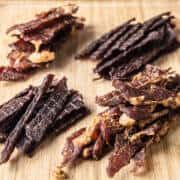










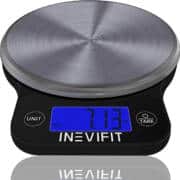



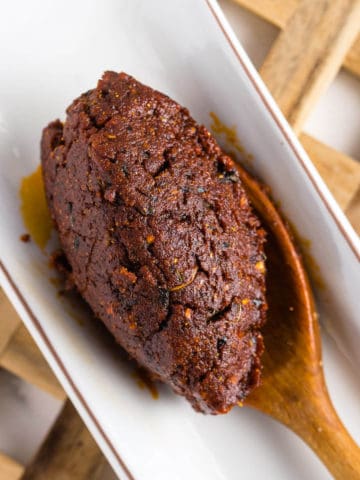
Comments
No Comments